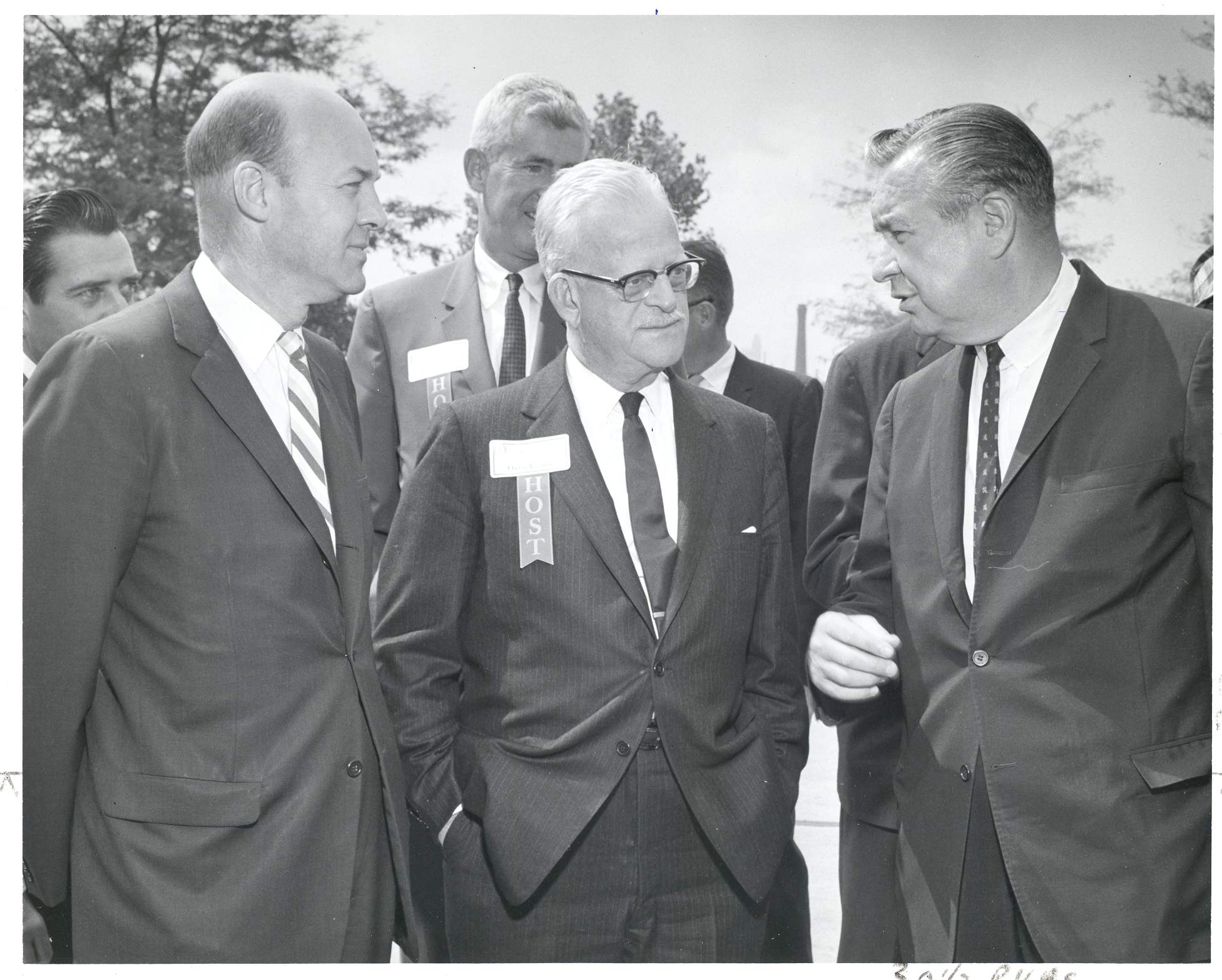
Expansion, Ecology and Energy: O-I During the 1950s-1970s
The Owens-Illinois Glass Company, in the decades following World War II, expanded its production and its investments both nationally and internationally and emerged as a research-oriented company. On April 19, 1950, William Levis retired as chairman of the board. His cousin, J. Preston Levis, succeeded him and Carl M. Megowen was elected president. Under the leadership of Levis and Megowen, O-I expanded through acquisitions and the development of new and improved products.
In 1946, O-I acquired the Kimble Glass Company which brought one of the world's leading producers of scientific glassware into the organization. As a result of cans capturing an increasing share of the soft drink and beer packaging market, O-I increased its promotion of the "one-way" non-returnable glass container. First known as the "Stubby" and then by the Duraglas tradename, this light-weight, durable glass bottle continued in popularity through the 1950s and early 1960s. Owens-Illinois had begun development work in 1942 on what would become known as Kaylo, a structural insulating material used for insulating buildings and pipes and as the inner core between laminates of wood, metal and plastics. Kaylo was used heavily during the postwar construction boom. The raw materials comprising this product were described as primarily the same used in the manufacture of glass with the end-product being light-weight, high-strength thermal insulation which was also fire-resistant. Production and sales problems, however, resulted in the decision to sell the Kaylo operations to Owens-Corning Fiberglas Corporation in 1958.
In 1954, Owens-Illinois Glass Company changed its name to Owens-Illinois, Inc. The changeover in this corporate identity was handled by a new centralized corporate marketing department. O-I began to expand its production and acquisitions to include a glass factory in Cuba. The factory was finished in 1958; unfortunately, two years later Fidel Castro's new government expropriated all U.S. holdings, including the glass factory. This did not damper O-I's interest in expanding internationally and in 1956, a reorganized international division was given the general responsibility for all company business outside the United States including its possessions, sale or leasing of machinery, and manufacturing. By 1960, O-I had expanded into the Bahamas, Belgium, Brazil, Canada, Colombia, West Germany, Japan, Switzerland and Venezuela.
By 1956, O-I was the nation's largest producer of glass containers and thus also the biggest user of corrugated shipping cartons. To alleviate the cost of purchasing the containerboard used in making the boxes, O-I acquired the National Container Company, one of the nation's largest producers of corrugated boxes and a major manufacturer of containerboard. This acquisition also included six paper mills, 18 converting plants or box shops, a turpentine company, two small short-line railroads, and over 925,000 acres of owned or leased timberland.
On September 25, 1955, O-I, with much acclaim, dedicated a new Technical Center on Westwood Avenue. This center brought together for the first time O-I's research and development group and its operating engineering staff. By opening this center and dramatically increasing funds dedicated to research and development, O-I was announcing the company's new emphasis on research involving the structure and characteristics of glass, glass surfaces, and other related products. One such product change that was in production by the end of the 1950s was the blown plastic container made of polyethylene, first used by one of O-I's major customers, Clorox Bleach.
In October 1961, Raymon Mulford succeeded Carl Megowen as president and chief operating officer. J. Preston Levis remained chairman of the board and chief executive officer. Mulford's main emphasis during the 1960s was on research, development, and marketing of new products. O-I's outlay for research quadrupled during his tenure. O-I investigated uses for glass ceramics, developed more efficient production lines for standard glass bottles, produced the two piece metal can, and tested display panels for computerized information. Much of this new product research and production took place at the Levis Development Park near Perrysburg, Ohio. In 1965, O-I purchased 383 acres as the site for a corporate industrial park which soon included pilot plant operations for new products developed by Owens-Illinois research.
O-I also continued its expansion and acquisition programs. In 1968, it acquired Lily-Tulip Corporation, one of the largest producers of disposal paper products. Another expansion project involving more humanitarian goals ended in disappointment. O-I had acquired timber cutting rights in the Bahamas when it purchased the National Container Company. By 1965, plans were made to transfer cutting rights from Abaco Island to Andros Island, but many of the local workers would not be able to move or find other employment. To assist them, Mulford sought advice from experts in agribusiness on a new business for the island, and they suggested cane sugar production. Owens-Illinois of the Bahamas, Limited, a new wholly-owned O-I subsidiary, signed an agreement with the Bahamian government on July 28, 1966, permitting the new company to establish a 20,000-acre sugar cane plantation, a 50,000-ton raw sugar processing mill, and a 1,000-ton refinery on Abaco. By 1968, fields were planted and processing began in January 1969. But with major losses occurring in 1969 and 1970, O-I finally realized that the rock-like coral soil could not grow a cane crop with enough sugar content to produce raw sugar profitably. By 1978, O-I sold their Abaco assets to the Bahamian government. Although some of the research and expansion projects did not prove profitable, other divisions within O-I's glass packaging, forest products and plastic products'continued to be highly successful.
On April 17, 1968, J. Preston Levis announced his retirement. Mulford succeeded Levis as board chairman and Edwin D. Dodd was named president and chief operating officer. Under Dodd's leadership, the 1970s saw O-I confronting issues of ecology and energy. As early as the 1950s, O-I recognized its environmental responsibilities. In 1953, O-I was instrumental in organizing Keep America Beautiful, Inc., a non-profit anti-litter organization supported primarily by contributions from the glass bottle and metal can manufacturers. By the late 1960s and early 1970s, environmental activists, recognizing that the very industries creating the litter were funding KAB, lobbied for more stringent controls over litter, either through a national ban or a tax on all non-returnables. To respond to the activists, O-I contributed on the national level to the formation of what would become known as the National Center for Resource Recovery Incorporated, established in 1970 to seek a systems approach to the solid waste problem, including home collection, recycling, separation, and recovery of useful components. In addition to supporting national research, O-I itself developed and publicized a series of waste processing and reuse projects including glass collection days, garbage separation plants, and end-use products made of glass and plastic residue such as shingles, building tiles and paving material.
The oil embargo of 1974-1975 and spiraling cost of crude oil challenged O-I to provide leadership in energy conservation research and development. O-I created a new energy management committee to review and coordinate energy conservation within the company. These techniques along with its 50 percent equity position in National Petro Chemicals Corporation allowed O-I to cut its use of purchased energy by more than a third by 1983. It also allowed O-I to maintain its supply of high-density polyethylene required for its plastic bottle business. During the 1970s, this highly-profitable division had successfully created, produced, and marketed the liter and two-liter plastic bottle for soft drinks.
Mulford announced his intention to retire as chief executive officer in December 1972, but would remain as chairman of the board. Dodd was named chief executive officer. Mulford's unexpected death in February 1973 resulted in Dodd also becoming chairman of the board.
The years between 1976 and 1980 saw the occurrence of a series of major national and international events involving O-I. On February 27, 1976, William F. Niehous, general manger of O-I Venezuelan operations, was kidnapped by terrorists. He would spend over three years in captivity before being freed. The first of a long-line of asbestos-related civil suits was filed in 1977 against O-I as a producer of Kaylo insulation. Although O-I had divested itself of Kaylo in 1958, selling it to Owens-Corning Fiberglas, they would be involved in litigation for many years. A third more optimistic event occurred in May 1979 when ground was broken for a new O-I world headquarters, becoming the catalyst for the revitalization of downtown Toledo.
At the Ward M. Canaday Center for Special Collections
Photograph of J. Preston Levis with Ohio Governor James Rhodes, touring the Libbey plant, August
1965. O-I, MSS-200.
J. Preston Levis started working at the Illinois glass factory in Alton after receiving a degree in chemical engineering at Cornell. His first job was on the line, forming and changing molds after job runs. After the merger with the Owens Botttle Company, he headed the newly acquired Owens-Illinois Pacific Glass Company. He returned to Toledo at the request of his cousin, William, to become vice president and general manger of O-I. After William retired, he was named chairman of the board and served in that position as well as chief executive officer until his retirement in 1968. He died on April 17, 1973.
Owens-Illinois Outlook, August 1962. O-I, MSS-200.
In 1922, Carl Megowen joined the Illinois Glass Company at Alton as an accountant. By 1932, he was employed at O-I as comptroller, and elected president in April 1950. Under his leadership, O-I expanded into a global enterprise and its assets and earnings substantially grew. This supplement, published after his death on July 21, 1962, highlights his career and accomplishments at O-I.
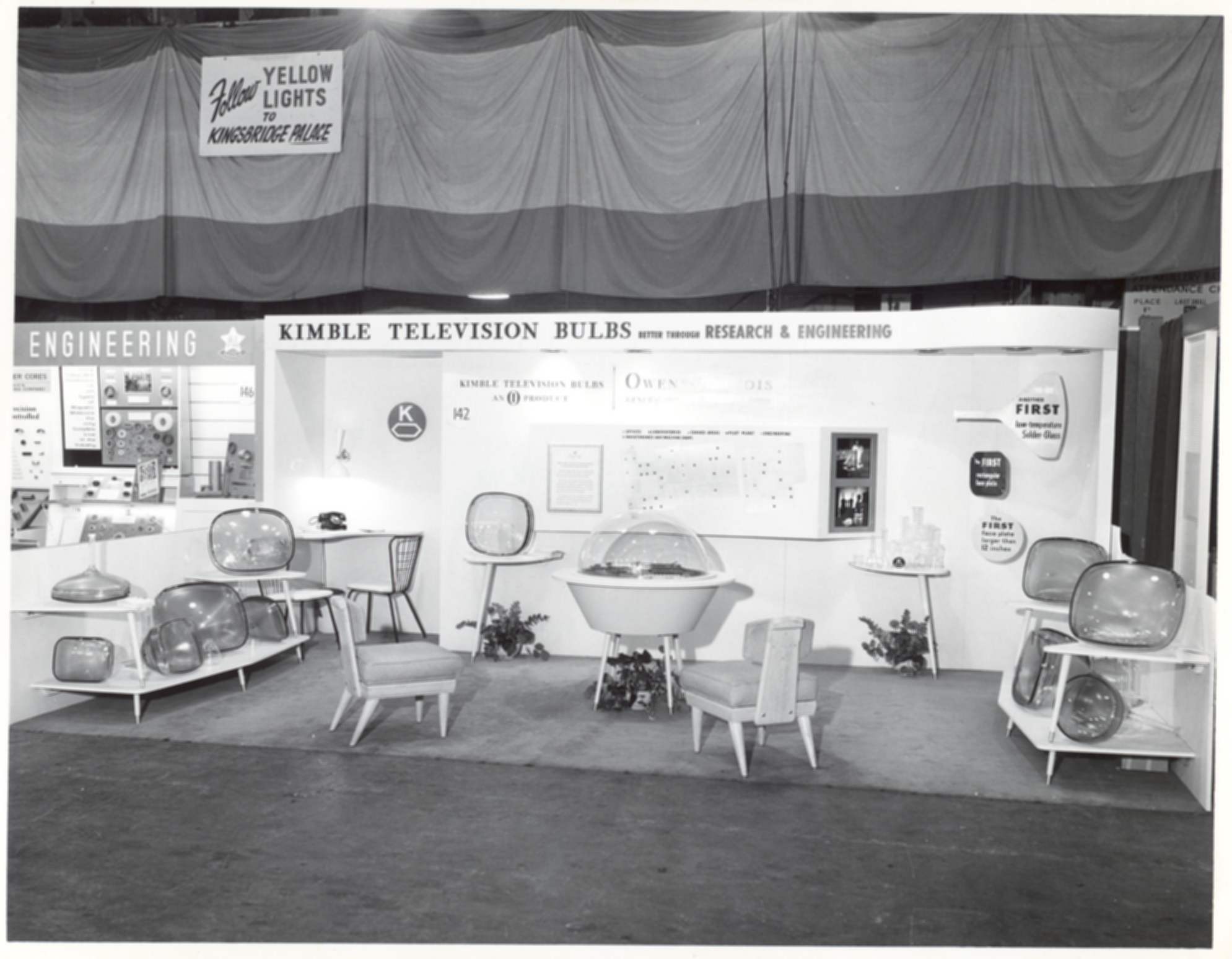 Photographs,
Kimble Glass Company purchase and sales displays, 1946, mid-1950s. O-I, MSS-200.
Photographs,
Kimble Glass Company purchase and sales displays, 1946, mid-1950s. O-I, MSS-200.
In 1946, O-I purchased the Kimble Glass Company, one of the world's leading producers of scientific glassware, glass tubing and rod, and ampules and vials. Depicted at the official acquisition is William Levis and on the right Col. E.E. Kimble. Under O-I management, Kimble Glass expanded into production of television bulbs, glass block, insulators, and glass tubing as illustrated by its sales displays.
Advertisement and photograph depicting Duraglas non-returnable bottles, 1954.
O-I, MSS-200.
The no-return glass bottles were advertised as safe, convenient, and less-costly than metal cans, which were becoming more popular in the soft drink and beer packaging market.
Photograph of Governor James Rhodes; Owens-Corning Fiberglas Chairman, Harold Boeschenstein; Martin
James; and President Dwight Eisenhower, ca. early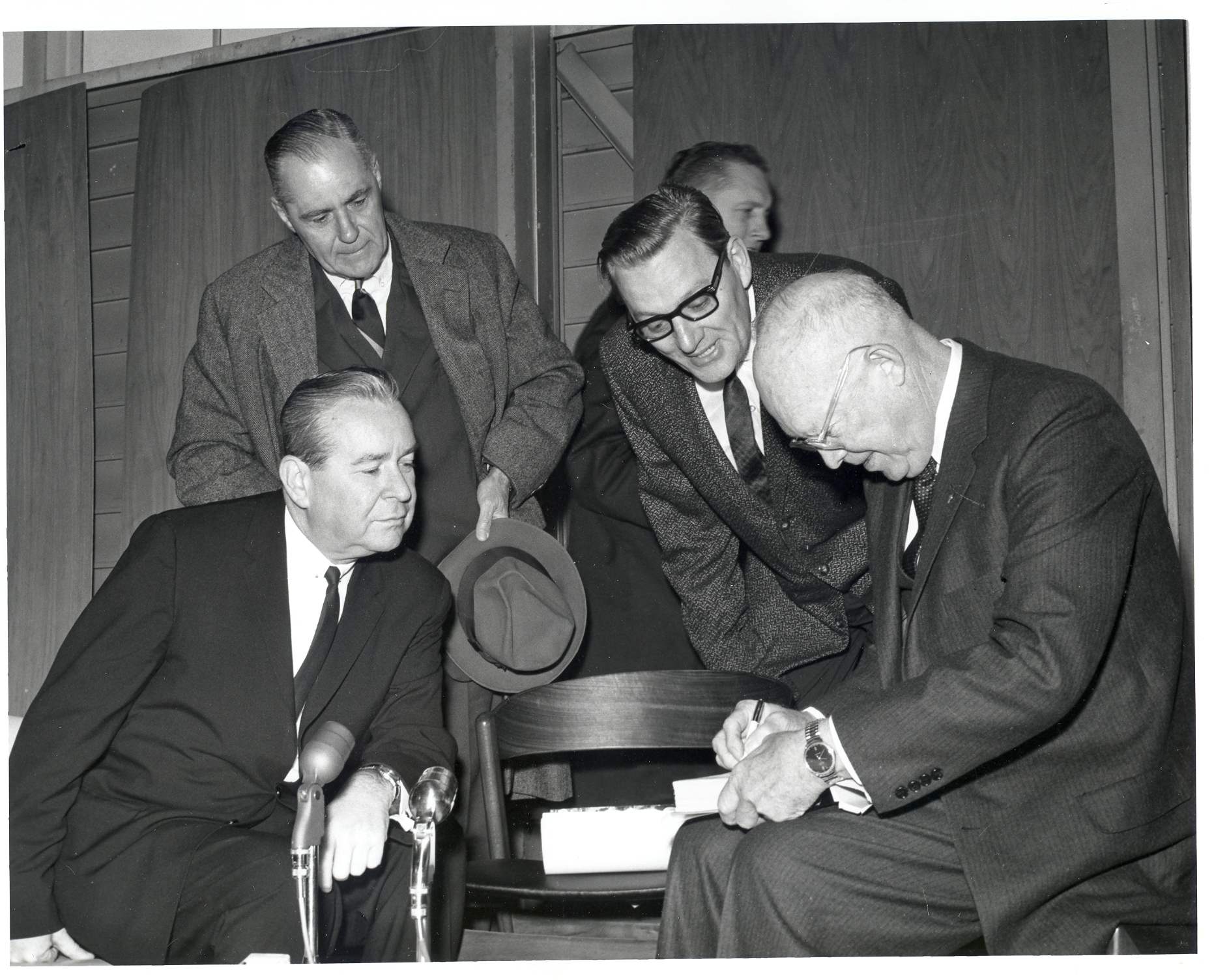 1960s.
1960s.
The Blade, November 1, 1963. Jack Paquette Papers, MSS-169.
Owens-Corning Fiberglas formed in 1938 when both O-I and Corning Glass Works decided to consolidate their patents, research programs, and production facilities regarding fibrous glass and form a new corporation. Harold Boeschenstein, vice president and general manager at O-I, became OCF's first president. He continued to lead this company until his retirement in 1971. OCF researched and produced many different products comprised of glass fibers including insulation, filters, textiles, and reinforcements for plastic products and automobile tires. Because of an anti-trust suit filed by the U.S. Justice Department in 1947 against O-I, OCF, and Corning Glass regarding the potential monopoly over glass fiber production, O-I and Corning Glass eventually divested themselves of their interests in OCF.
Photograph of O-I and Cuban officials, Havana, Cuba, 1955. O-I, MSS-200.
Pictured in the middle of the group are J. Preston Levis and General Fulgencio Batista, president of Cuba, after the purchase by O-I of 148 acres outside Havana for a glass container factory. Built in 1958, the factory operated only two years. After the overthrow of the Batista government, Fidel Castro nationalized all U.S. industries in Cuba.
Photographs and dedication program, O-I Technical Center, September 25, 1955. O-I, MSS-200.
J. Preston Levis and Carl Megowen officially opened the Technical Center on Westwood Avenue. Bringing together O-I's research and engineering employees, O-I illustrated its commitment to improving existing products and creating new ones. The Technical Center occupied almost 200,000 square feet of pilot plant operations, laboratories, drafting rooms, a technical library, and offices. It employed about 500 scientists, technicians, engineers, and production staff.
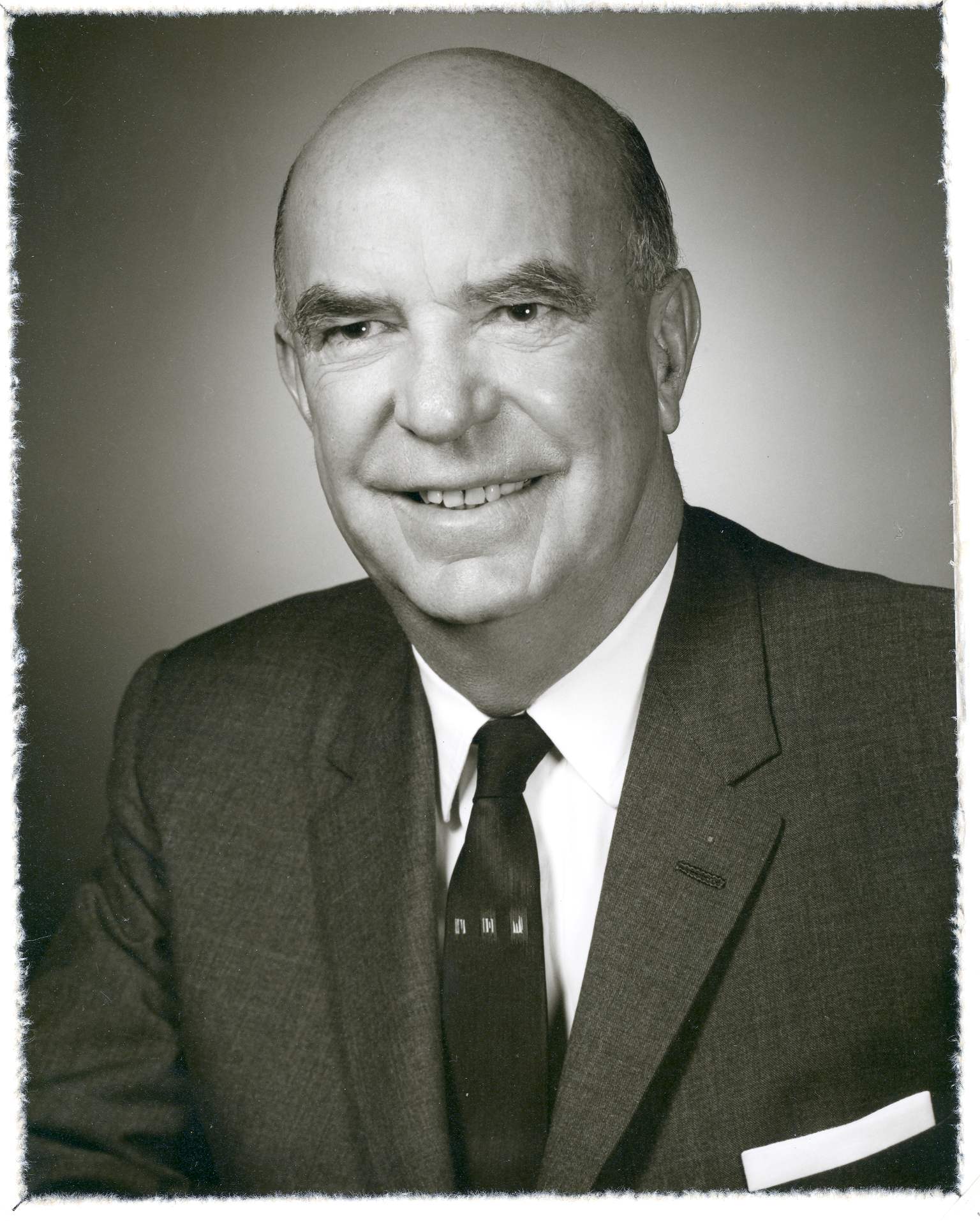 Photograph
of Raymon Mulford, ca. 1968. O-I, MSS-200.
Photograph
of Raymon Mulford, ca. 1968. O-I, MSS-200.
Raymon Mulford succeeded Carl Megowen as president and chief operating officer of O-I in October 1961. In April 1968, upon the retirement of J. Preston Levis, Mulford became chairman of the board until his death on February 8, 1973. The son of a glassblower in California, Mulford attended the Harvard Business School on a scholarship. Graduating in 1933, he was hired by O-I and worked in various plants in managerial positions. In 1949 he returned to Toledo to create and manage a new corporate personnel administration department. In 1956, he became president of the Kimble Glass Company and then returned to the O-I headquarters in Toledo to be groomed for the position of president.
Seven Human Principles, 1964. O-I, MSS-200.
These principles, developed by Mulford when he served as head of the personnel administration department, were officially announced to O-I employees in 1964. They reflect Mulford's management philosophy and were seen by most O-I employees every working day as they hung on the walls of offices and public places of all O-I facilities.
Photograph, Levis Development Park, Perrysburg, Ohio, ca. 1967. O-I, MS-200.
Named for William and J. Preston Levis, O-I first established this industrial park in 1965 to commercially develop products conceived at the Technical Center. This park was unique in that it was composed of small units all owned by the same company. In 1971, some of the land was donated to Bowling Green State University and the University of Toledo to use for a shared regional computing center. The building that once housed the Technical Center now houses the Northwest Ohio Regional Book Depository, a facility operated jointly by BGSU and UT.
Photographs, sugar cane plantation, Abaco Island, Bahamas, November 1968, January 1969. O-I, MSS-200.
O-I held timber cutting rights in the Bahamas. Once the cut was completed on Abaco Island, O-I established a sugar cane plantation and built a sugar processing plant to provide employment to its workers. Although the fields and the plant never became profitable and were eventually sold to the Bahamian government, this endeavor illustrated O-I's commitment to their overseas businesses and employees. The photographs depict workers' homes and the plant operations.
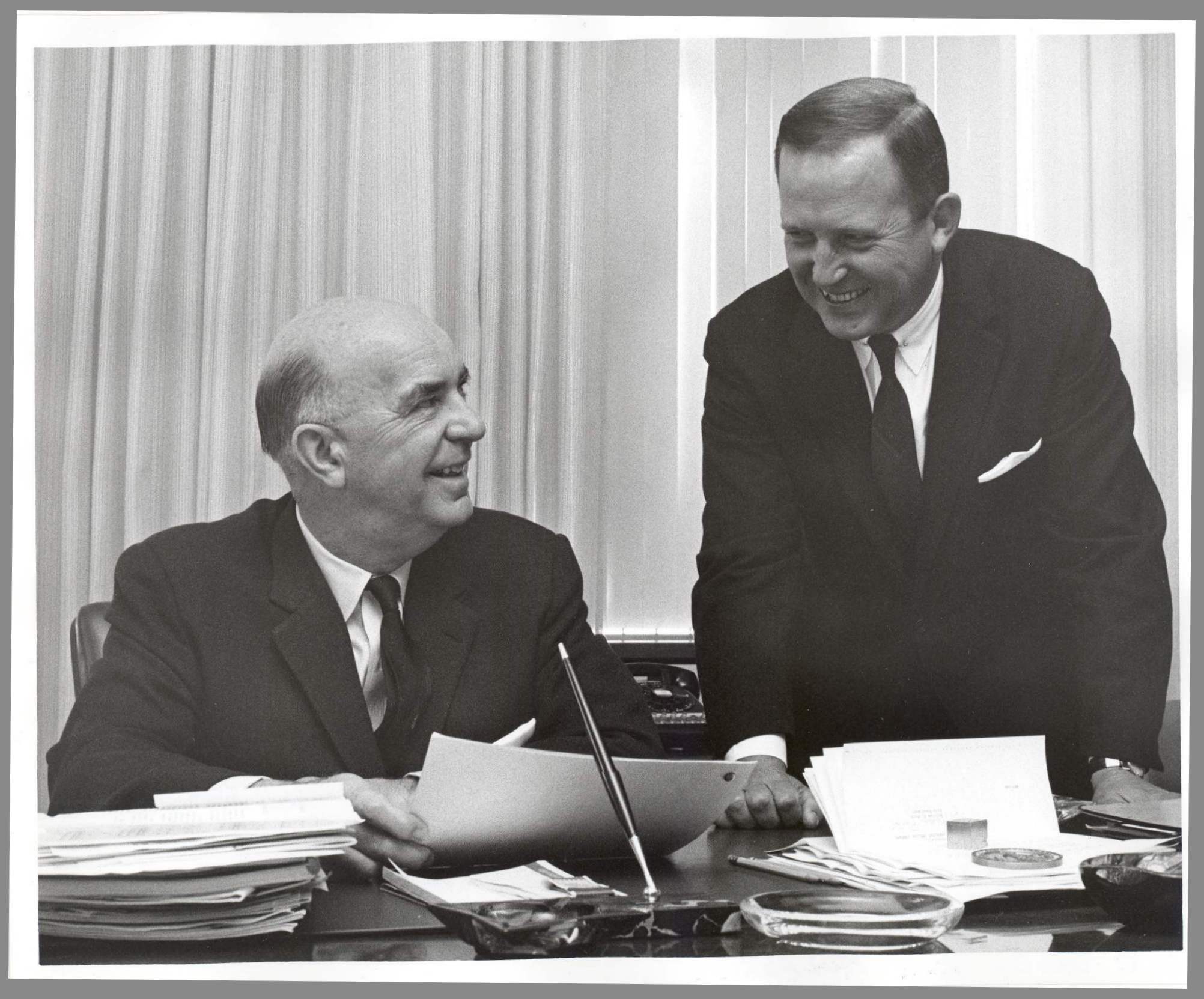 Photographs, Edwin D.
Dodd with Ray Mulford, 1968. O-I, MSS-200.
Photographs, Edwin D.
Dodd with Ray Mulford, 1968. O-I, MSS-200.
In 1968, Mulford succeeded Levis as chairman of the board and Edwin Dodd was named as president and chief operating officer. After completing graduate work at the Harvard School of Business Administration, Dodd served in the Pacific during WWII. He joined O-I in 1946 and by 1961, was general manager of the Forest Products Division. He would lead O-I until his retirement in 1984.
Photograph, Mrs. Lyndon Johnson with J. Preston Levis, 1965. O-I, MSS-200.
The First Lady assisted in awarding O-I the Keep America Beautiful, Inc. annual Business Award for the company's contributions to the anti-litter fight. J. Preston Levis accepted the award as Smith Rairdon, retired executive vice-president of O-I and one of the founders of KAB, looks on. Also pictured is Reuben Perin, KAB president.
Photographs, glass collection days, Toledo, 1970. O-I, MSS-200.
Responding to the concerns of environmentalists regarding solid waste problems caused by the bottle and metal can industries, O-I developed various programs to promote recycling. Glass collection days were sponsored in several cities during which non-returnable glass bottles could be turned in for recycling. On August 21 and 22, 1970, O-I purchased 68 tons of old glass containers from about 1,200 residents in Toledo. In one picture, Ray Mulford and Edwin Dodd meet Erin and Tom Quinn to ceremoniously weigh the first of 400 pounds of glass they had collected. Much of this recycled glass would be used to produce Glasphalt paving for a section of the road to be installed in front of a new administration building being built by O-I at its Technical Center.
News articles from The Blade and the Owens-Illinois Outlook, 1976 and 1979, on the kidnapping and release of William Niehous. O-I, MSS-200.
On February 27, 1976, William F. Niehous, general manager of O-I operations in Venezuela, was kidnapped from his home by members of the Argimiro Gabaldon Revolutionary Council. Niehous was responsible for the operation of a sales office and three production plants manufacturing glass containers, closures, and flat glass, with a total employment of 1,600. The kidnappers demanded that O-I publish their manifesto in local and international newspapers, distribute a $116 bonus for all Venezuelan O-I workers, and distribute food to 1200 Venezuelan families in each of 15 poor neighborhoods. The Venezuelan government prohibited publication of the manifesto in Venezuela. O-I went ahead and published it in several international newspapers. Angered, the Venezuelan government threatened to seize ownership of the O-I de Venezuela. Over three years later, on June 29, 1979, Niehous was found and freed by Venezuelan police as they searched for cattle rustlers.